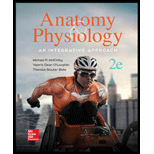
Concept explainers
To summarize:
Glycolysis, including where it occurs in a cell if it requires oxygen, the substrate and final product, and the formation of energy containing molecules (ATP, NADH, FADH2).
Concept introduction:
Aerobic respiration occurs in the presence of oxygen and energy is released in the form of ATP (adenosine triphosphate). It occurs in two steps; glycolysis and Kreb’s cycle. In glycolysis, glucose is broken down into pyruvate. This pyruvate is fully oxidized in the mitochondria during Kreb’s cycle. The process of glycolysis was given and described by Embden, Meyerhof, and Parnas. It involves the splitting of one molecule of glucose into two molecules of pyruvic acid or pyruvate. In this process, the energy produced is in the form of ATP and NADH (Nicotinamide adenine dinucleotide).
Want to see the full answer?
Check out a sample textbook solution
Chapter 3 Solutions
Anatomy & Physiology: An Integrative Approach
- Give the Steps, Enzyme/s involved, Electron carriers, ATP Generation, End product and significance of the following metabolic pathway: Fermentation (explain in 1-3 sentences only)arrow_forwardDiscuss, with reference to the biological roles of glucose and oxygen, the full process of aerobic respiration. Show clear detail of all the steps of aerobic respiration, the key products as well as the specific locations of the stages in the cell. Use key terminology and good detail.arrow_forwardCompare the three modes of ATP synthesis: Oxidative phosphorylation, Photophosphorylation, Substrate level phosphorylation. Including description of how each works, the different components and how they interact to synthesize ATP, the major molecules involved, and any energy transformations and their uses.arrow_forward
- Briefly describe the steps in catabolism of glucose; showing the location where each step happens in prokaryotic and eukaryotic cells.arrow_forwardSeveral general characteristics of metabolic reactions or reaction pathways are listed. Classify them into the appropriate metabolic category. utilize ATP Anabolism convert NAD+ to NADH convert small compounds to larger compounds Answer Bank convert NADPH to NADP+ generally exergonic (spontaneous) Catabolism convert large compounds to smaller compoundsarrow_forwardComplete the interrelated pathways by providing the neccesary metabolite, enzyme, reaction or metabolic pathway. Use abbreviations/acronyms (except for coenzyme)arrow_forward
- Give the Steps, Enzyme/s involved, Electron carriers, ATP Generation, End product and significance of the following metabolic pathway: Lipid Metabolism (explain in 1-3 sentences only) P.S add row if necessaryarrow_forwardClassify the following into either activation processes or inhibitions processes. Process Phosphorylation of a transport protein (i.e. pump) The binding of a substrate molecule at the active site of an enzyme The binding of a molecule at the active site of an enzyme, but in place of the substrate The allosteric binding of ATP to the phosphofructokinase (an enzyme part of glycolysis)arrow_forwardDescribe the oxidative phosphorylation/electron transport chain. Be sure to include all components and its location.arrow_forward
- Multiple Choice: A. Glycolysis “uses” ATP by: Reducing CO2 Substrate-level phosphorylation Anabolism Oxidative phosphorylation B. Labels glucose for glycogenesis. GTP ATP CTP UTP C. The enzymes involved in the anaerobic reactions of pyruvate are (naka checkbox, so pwede more than one it answer) Releases energy by producing ATP Coenzymes act as oxidizing agents for the oxidation of metabolites Examples are glycolysis, PPP, & photosynthesis Breakdown of larger molecules into smaller onesarrow_forwardDraw all the steps in glycolysis, including: names and structures of all metabolites, names of enzyme(s) responsible for each step, and an indication of whether each step is reversible or not.arrow_forwardMake a flow chart diagram of each step in Glycolysis. Identify the biochemical reactions in each step and its corresponding enzymes and coenzymes.arrow_forward
 Human Anatomy & Physiology (11th Edition)BiologyISBN:9780134580999Author:Elaine N. Marieb, Katja N. HoehnPublisher:PEARSON
Human Anatomy & Physiology (11th Edition)BiologyISBN:9780134580999Author:Elaine N. Marieb, Katja N. HoehnPublisher:PEARSON Biology 2eBiologyISBN:9781947172517Author:Matthew Douglas, Jung Choi, Mary Ann ClarkPublisher:OpenStax
Biology 2eBiologyISBN:9781947172517Author:Matthew Douglas, Jung Choi, Mary Ann ClarkPublisher:OpenStax Anatomy & PhysiologyBiologyISBN:9781259398629Author:McKinley, Michael P., O'loughlin, Valerie Dean, Bidle, Theresa StouterPublisher:Mcgraw Hill Education,
Anatomy & PhysiologyBiologyISBN:9781259398629Author:McKinley, Michael P., O'loughlin, Valerie Dean, Bidle, Theresa StouterPublisher:Mcgraw Hill Education, Molecular Biology of the Cell (Sixth Edition)BiologyISBN:9780815344322Author:Bruce Alberts, Alexander D. Johnson, Julian Lewis, David Morgan, Martin Raff, Keith Roberts, Peter WalterPublisher:W. W. Norton & Company
Molecular Biology of the Cell (Sixth Edition)BiologyISBN:9780815344322Author:Bruce Alberts, Alexander D. Johnson, Julian Lewis, David Morgan, Martin Raff, Keith Roberts, Peter WalterPublisher:W. W. Norton & Company Laboratory Manual For Human Anatomy & PhysiologyBiologyISBN:9781260159363Author:Martin, Terry R., Prentice-craver, CynthiaPublisher:McGraw-Hill Publishing Co.
Laboratory Manual For Human Anatomy & PhysiologyBiologyISBN:9781260159363Author:Martin, Terry R., Prentice-craver, CynthiaPublisher:McGraw-Hill Publishing Co. Inquiry Into Life (16th Edition)BiologyISBN:9781260231700Author:Sylvia S. Mader, Michael WindelspechtPublisher:McGraw Hill Education
Inquiry Into Life (16th Edition)BiologyISBN:9781260231700Author:Sylvia S. Mader, Michael WindelspechtPublisher:McGraw Hill Education





